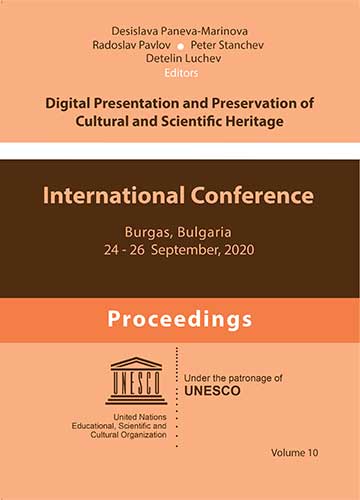Usage of Geospatial Augmented Reality for the Representation of National Heritage
DOI:
https://doi.org/10.55630/dipp.2025.15.9Keywords:
Augmented Reality, National Heritage, Mobile Application, ARCore Geospatial APIAbstract
The technology of augmented reality can significantly improve the presentation of national heritage. This technology provides quick and more intuitive information search about heritage site landmarks compared to classical technologies that use keywords or scrolling lists. In this paper, we present a mobile application based on geospatial augmented reality technology to present outdoor heritage sites. We provide a detailed description dedicated to the hybrid type of AR tracking that uses ARCore Geospatial API. Also, we present the system's architecture and illustrate its application on the examples of monuments in the city of Niš.References
Banterle, F., Cardillo, F. A., Malomo, L., Pingi, P., Gabellone, F., Amato, G., & Scopigno, R. (2015). LecceAR: an augmented reality app. Digital Presentation and Preservation of Cultural and Scientific Heritage, 5, 99-108. https://doi.org/10.55630/dipp.2015.5.9
Boboc, R. G., Băutu, E., Gîrbacia, F., Popovici, N., & Popovici, D. M. (2022). Augmented reality in cultural heritage: an overview of the last decade of applications. Applied Sciences, 12 (19), 9859. https://doi.org/10.3390/app12199859
Cisternino, D., Corchia, L., Luca, V. D., Gatto, C., Liaci, S., Scrivano, L., Trono, A. & De Paolis, L. T. (2021). Augmented reality applications to support the promotion of cultural heritage: The case of the basilica of Saint Catherine of Alexandria in Galatina. Journal on Computing and Cultural Heritage (JOCCH), 14 (4), 1-30. https://doi.org/10.1145/3460657
Dima, M. (2022). A design framework for smart glass augmented reality experiences in heritage sites. Journal on Computing and Cultural Heritage (JOCCH), 15 (4), 1-19. http://dx.doi.org/10.1145/3490393
Google. (2025). ARCore Geospatial API. Google Developers. https://developers.google.com/ar/develop/geospatial
Kleftodimos, A., Evagelou, A., Triantafyllidou, A., Grigoriou, M., & Lappas, G. (2023). Location-based augmented reality for cultural heritage communication and education: The Doltso district application. Sensors, 23 (10), 4963. https://doi.org/10.3390/s23104963
Kratchanov, I., & Minev, D. (2024). Adventure in Plovdiv's cultural space: An augmented reality serious game. Digital Presentation and Preservation of Cultural and Scientific Heritage, 14, 281-288. https://doi.org/10.55630/dipp.2024.14.27
Lee, Y. Y., Lee, J. H., Ahmed, B., Son, M. G., & Lee, K. H. (2019). A new projectionbased exhibition system for a museum. Journal on Computing and Cultural Heritage (JOCCH), 12 (2), 1-17. https://doi.org/10.1145/3275522
O’dwyer, N., Zerman, E., Young, G. W., Smolic, A., Dunne, S., & Shenton, H. (2021). Volumetric video in augmented reality applications for museological narratives: A user study for the Long Room in the Library of Trinity College Dublin. Journal on Computing and Cultural Heritage (JOCCH), 14 (2), 1-20. https://dl.acm.org/doi/10.1145/3425400
Paneva- Marinova, D., Luchev, D., Goynov, M., Mitreva, E., Pavlov, R., & Tatić, D. (2023). Smart m-observation and study of Orthodox art. In Interactive Mobile Communication, Technologies and Learning (pp. 57-62). Springer Nature Switzerland. https://doi.org/10.1007/978-3-031-56075-0_6
Tatić, D. (2022). Mobile presentation of the war history of the city of Niš. Digital Presentation and Preservation of Cultural and Scientific Heritage, 12, 151-159. https://doi.org/10.55630/dipp.2022.12.12
Tatić, D., & Stanković, R. S. (2024). Augmented reality software in presentation of cultural and historical heritage. Digital Presentation and Preservation of Cultural and Scientific Heritage, 14, 71-82. https://doi.org/10.55630/dipp.2024.14.6
Downloads
Published
How to Cite
Issue
Section
License
Copyright (c) 2025 Digital Presentation and Preservation of Cultural and Scientific Heritage

This work is licensed under a Creative Commons Attribution-NonCommercial 4.0 International License.



